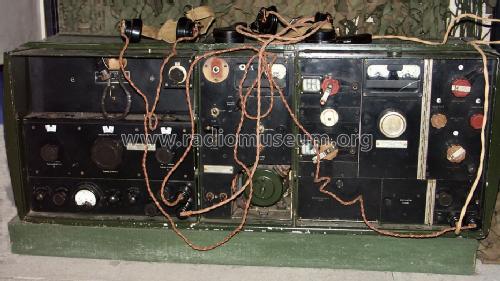Wireless Set No.9
MILITARY U.K. (different makers for same model)
- País
- Gran Bretaña (GB)
- Fabricante / Marca
- MILITARY U.K. (different makers for same model)
- Año
- 1939–1941
- Categoría
- Transceptor militar
- Radiomuseum.org ID
- 203293
- Numero de valvulas
- 11
- Principio principal
- Transceiver; ZF/IF 420 kHz
- Gama de ondas
- Onda Corta solamente
- Tensión de funcionamiento
- Bateria recargable / 12 Volt
- Altavoz
- - Este modelo usa amplificador externo de B.F.
- Material
- Metálico
- de Radiomuseum.org
- Modelo: Wireless Set No.9 - MILITARY U.K. different makers
- Forma
- Boatanchor (militar, profesional >20 kg).
- Ancho, altura, profundidad
- 41 x 16 x 12 inch / 1041 x 406 x 305 mm
- Anotaciones
- Wireless set No. 9: Medium range transceiver covering 1,875 - 5 MHz, AM (A3), MCW (A2) and CW (A1), pout 5 Watt telephony, 10 Watt CW;
powered by 12 V 125 Ah accumulator for heaters and rotary transformer for 1100 V HT and anode converter for 200 V for transmitter ans receiver; six foot rod antenna;
used by British Army for medium range communications between armoured fighting vehicles and on trucks for Division signals.
The Wireless Set No. 9 consists of a receiver unit, a supply unit in the middle and a transmitter unit at the right. The set is equipped with to identical master oscillator and antenna tuning circuits for a red and blue channel which can be changed by a two position frequency change switch (also referred as "flick mechanism"). Only early models also feature crystal controlled operation.
The set replaced the less successful W.S. 2 and 7, has been produced in a first batch of 50 and another 200 sets in 1937 by Standard Telephones and Cables, until 1941, a total of about 400 sets have been made.
The set has seen very much use as AFC set in the Western Desert campaign in 1940/1941; it has been replaced by Wireless Set 12 as ground station and vehicle station and by the popular Wireless Set 19 as AFV / tank set.
- Mencionado en
- Wireless for the Warrior Vol. 1, L. Meulstee
- Autor
- Modelo creado por Martin Bösch. Ver en "Modificar Ficha" los participantes posteriores.
- Otros modelos
-
Donde encontrará 152 modelos, 120 con imágenes y 49 con esquemas.
Ir al listado general de MILITARY U.K. (different makers for same model)
